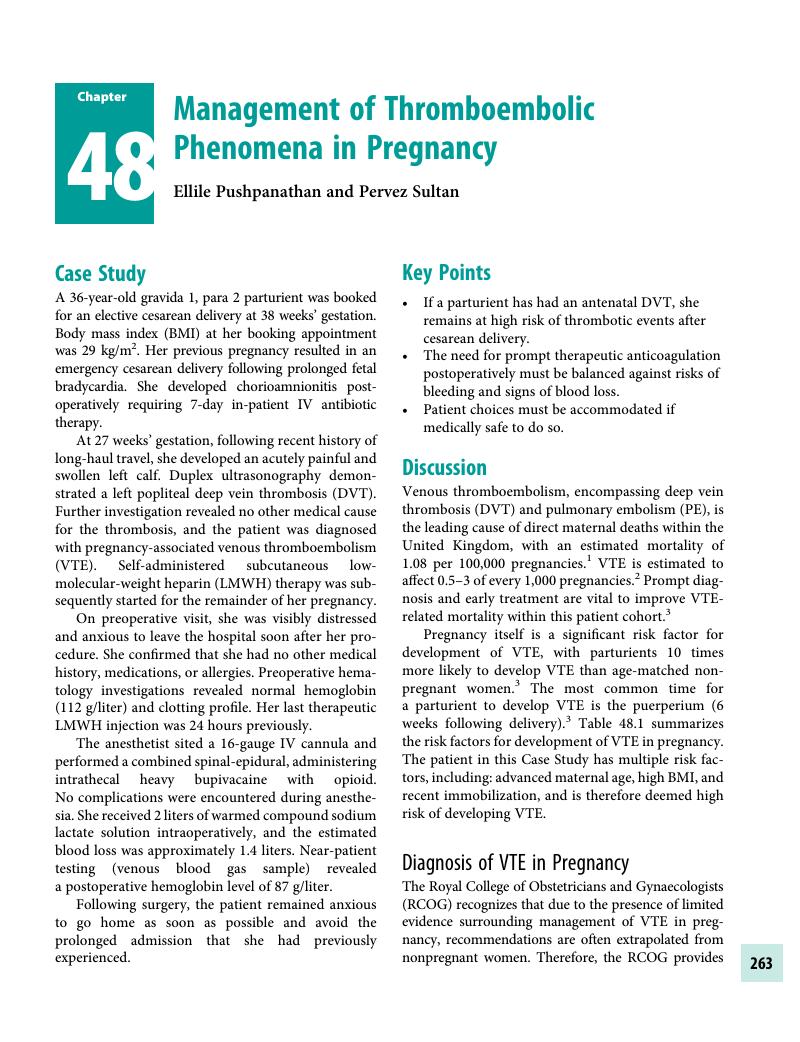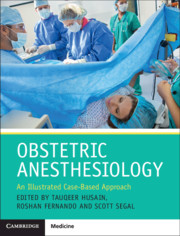Book contents
- Obstetric Anesthesiology
- Obstetric Anesthesiology
- Copyright page
- Dedication
- Contents
- Contributors
- Chapter 1 Eating and Drinking in Labor
- Chapter 2 Epidural Analgesia Maintenance
- Chapter 3 Breakthrough Pain after Labor Epidural Analgesia
- Chapter 4 Epidural Analgesia and Intrapartum Fever
- Chapter 5 Tips and Tricks for Labor Neuraxial Block
- Chapter 6 Spinal Ultrasound for Neuraxial Anesthesia Placement
- Chapter 7 Combined Spinal-Epidural Anesthesia/Analgesia
- Chapter 8 Nonpharmacologic Analgesia for Childbirth
- Chapter 9 Systemic Pharmacologic Analgesia
- Chapter 10a Consent Considerations in Maternity: A US Perspective
- Chapter 10b Consent Considerations in Maternity: A UK Perspective
- Chapter 11 Accidental Dural Puncture
- Chapter 12 Fetal Heart Rate Monitoring for the Obstetric Anesthesiologist
- Chapter 13 Multidisciplinary Team Management
- Chapter 14 Obstetric Early Warning Systems
- Chapter 15 Obesity in Pregnancy
- Chapter 16 Complex Adult Congenital Heart Disease in Pregnancy
- Chapter 17 Hematologic Disorders in Pregnancy
- Chapter 18 Respiratory Disorders in Pregnancy
- Chapter 19 Liver Disorders in Pregnancy
- Chapter 20 Neurologic Disorders in Pregnancy
- Chapter 21 Abnormal Placentation
- Chapter 22 Role of Transthoracic Echocardiography in Hypertensive Disorders of Pregnancy
- Chapter 23 Elective Cesarean Delivery
- Chapter 24 Emergency Delivery for Fetal Distress
- Chapter 25 Uterotonic Use
- Chapter 26 Postpartum Sterilization/Tubal Ligation
- Chapter 27 Nondelivery Procedures
- Chapter 28 Preterm Labor
- Chapter 29 Accidental Awareness during General Anesthesia in Obstetrics
- Chapter 30 Failed Epidural Top-Up for Cesarean Delivery
- Chapter 31 Maternal Hypotension after Neuraxial Anesthesia
- Chapter 32 Management of an Anticipated and Unanticipated Difficult Airway in a Pregnant Patient
- Chapter 33 Major Obstetric Hemorrhage and Point-of-Care Testing
- Chapter 34 Cell Salvage for Cesarean Delivery with High Risk of Hemorrhage
- Chapter 35 Emergency Hysterectomy
- Chapter 36 Interventional Radiology
- Chapter 37 Amniotic Fluid Embolism
- Chapter 38 Local Anesthetic Toxicity
- Chapter 39 Medicolegal Issues
- Chapter 40 Chronic Pain after Pregnancy
- Chapter 41 Neurologic Deficits Following a Primary Elective Cesarean Delivery under Spinal Anesthesia
- Chapter 42 Management of Post–Dural Puncture Headache
- Chapter 43 Nonobstetric Surgery during Pregnancy
- Chapter 44 Trauma in Pregnancy
- Chapter 45 Ischemic Heart Disease and Myocardial Infarction in Pregnancy
- Chapter 46 Intracranial Lesions in Pregnancy
- Chapter 47 Sepsis in Obstetrics
- Chapter 48 Management of Thromboembolic Phenomena in Pregnancy
- Chapter 49 Pandemic Flu
- Reference Ranges in Pregnancy
- Index
- References
Chapter 48 - Management of Thromboembolic Phenomena in Pregnancy
Published online by Cambridge University Press: 08 March 2019
- Obstetric Anesthesiology
- Obstetric Anesthesiology
- Copyright page
- Dedication
- Contents
- Contributors
- Chapter 1 Eating and Drinking in Labor
- Chapter 2 Epidural Analgesia Maintenance
- Chapter 3 Breakthrough Pain after Labor Epidural Analgesia
- Chapter 4 Epidural Analgesia and Intrapartum Fever
- Chapter 5 Tips and Tricks for Labor Neuraxial Block
- Chapter 6 Spinal Ultrasound for Neuraxial Anesthesia Placement
- Chapter 7 Combined Spinal-Epidural Anesthesia/Analgesia
- Chapter 8 Nonpharmacologic Analgesia for Childbirth
- Chapter 9 Systemic Pharmacologic Analgesia
- Chapter 10a Consent Considerations in Maternity: A US Perspective
- Chapter 10b Consent Considerations in Maternity: A UK Perspective
- Chapter 11 Accidental Dural Puncture
- Chapter 12 Fetal Heart Rate Monitoring for the Obstetric Anesthesiologist
- Chapter 13 Multidisciplinary Team Management
- Chapter 14 Obstetric Early Warning Systems
- Chapter 15 Obesity in Pregnancy
- Chapter 16 Complex Adult Congenital Heart Disease in Pregnancy
- Chapter 17 Hematologic Disorders in Pregnancy
- Chapter 18 Respiratory Disorders in Pregnancy
- Chapter 19 Liver Disorders in Pregnancy
- Chapter 20 Neurologic Disorders in Pregnancy
- Chapter 21 Abnormal Placentation
- Chapter 22 Role of Transthoracic Echocardiography in Hypertensive Disorders of Pregnancy
- Chapter 23 Elective Cesarean Delivery
- Chapter 24 Emergency Delivery for Fetal Distress
- Chapter 25 Uterotonic Use
- Chapter 26 Postpartum Sterilization/Tubal Ligation
- Chapter 27 Nondelivery Procedures
- Chapter 28 Preterm Labor
- Chapter 29 Accidental Awareness during General Anesthesia in Obstetrics
- Chapter 30 Failed Epidural Top-Up for Cesarean Delivery
- Chapter 31 Maternal Hypotension after Neuraxial Anesthesia
- Chapter 32 Management of an Anticipated and Unanticipated Difficult Airway in a Pregnant Patient
- Chapter 33 Major Obstetric Hemorrhage and Point-of-Care Testing
- Chapter 34 Cell Salvage for Cesarean Delivery with High Risk of Hemorrhage
- Chapter 35 Emergency Hysterectomy
- Chapter 36 Interventional Radiology
- Chapter 37 Amniotic Fluid Embolism
- Chapter 38 Local Anesthetic Toxicity
- Chapter 39 Medicolegal Issues
- Chapter 40 Chronic Pain after Pregnancy
- Chapter 41 Neurologic Deficits Following a Primary Elective Cesarean Delivery under Spinal Anesthesia
- Chapter 42 Management of Post–Dural Puncture Headache
- Chapter 43 Nonobstetric Surgery during Pregnancy
- Chapter 44 Trauma in Pregnancy
- Chapter 45 Ischemic Heart Disease and Myocardial Infarction in Pregnancy
- Chapter 46 Intracranial Lesions in Pregnancy
- Chapter 47 Sepsis in Obstetrics
- Chapter 48 Management of Thromboembolic Phenomena in Pregnancy
- Chapter 49 Pandemic Flu
- Reference Ranges in Pregnancy
- Index
- References
Summary

- Type
- Chapter
- Information
- Obstetric AnesthesiologyAn Illustrated Case-Based Approach, pp. 263 - 267Publisher: Cambridge University PressPrint publication year: 2019



